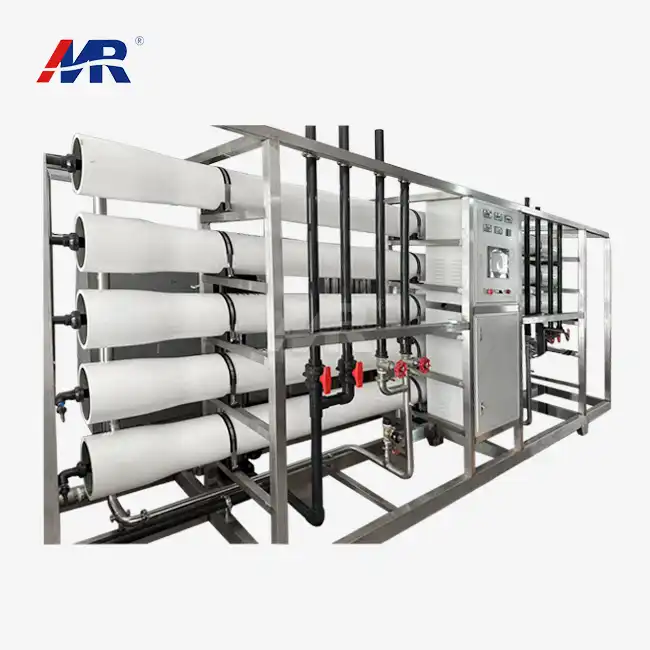Common Causes of Pressure Drops in RO Systems
Understanding the factors that contribute to pressure drops in your reverse osmosis system is essential for maintaining optimal performance. Several issues can lead to decreased pressure, each requiring a different approach to resolve:
Membrane Fouling and Scaling
One of the primary culprits behind pressure drops is membrane fouling. This occurs when contaminants accumulate on the membrane surface, impeding water flow and reducing filtration efficiency. Scaling, a specific type of fouling caused by mineral deposits, can be particularly problematic in hard water areas. Regular membrane cleaning and proper pretreatment can help mitigate these issues.
Feed Water Quality Fluctuations
Changes in feed water quality can significantly impact system pressure. Increased levels of suspended solids or dissolved contaminants may overburden pretreatment systems, leading to reduced flow rates and pressure drops. Monitoring feed water quality and adjusting pretreatment processes accordingly is crucial for maintaining consistent performance.
Clogged Prefilters
Prefilters play a vital role in protecting RO membranes from larger particles. However, as these filters trap contaminants, they can become clogged, restricting water flow and causing pressure drops throughout the system. Regular inspection and replacement of prefilters are essential maintenance tasks.
Faulty Pressure Regulators
Pressure regulators control the water pressure entering the RO system. A malfunctioning regulator can lead to inconsistent or low pressure, affecting the entire purification process. Periodic checks and calibration of pressure regulators can prevent these issues.
Pump Failure Diagnosis in Reverse Osmosis Plants
The high-pressure pump is the heart of any reverse osmosis plant, responsible for generating the pressure necessary for the osmosis process. When pump performance declines, it can lead to significant pressure drops and reduced system efficiency. Here's how to diagnose and address pump-related issues:
Identifying Pump Cavitation
Cavitation occurs when vapor bubbles form and collapse within the pump, causing damage and reduced performance. Signs of cavitation include unusual noise, vibration, and decreased pump output. Proper pump sizing and maintaining adequate suction pressure can help prevent cavitation.
Motor and Electrical Issues
Electrical problems, such as loose connections or motor winding failures, can lead to pump underperformance. Regular electrical system inspections and motor current analysis can detect these issues early, preventing unexpected downtime.
Mechanical Wear and Tear
Over time, mechanical components like impellers, bearings, and seals can wear out, reducing pump efficiency and pressure output. Implementing a preventive maintenance schedule, including regular inspections and component replacements, can extend pump life and maintain optimal performance.
Pump Curve Analysis
Comparing actual pump performance against its design curve can reveal efficiency losses or improper sizing. This analysis can help determine if a pump rebuild or replacement is necessary to restore system pressure and flow rates.
Checking for Leaks in BWRO Plant Piping
Leaks in the piping system of a BWRO plant can lead to significant pressure losses and reduced efficiency. Identifying and repairing these leaks is crucial for maintaining optimal system performance:
Visual Inspection Techniques
Regular visual inspections of piping, fittings, and connections can reveal obvious leaks or signs of corrosion. Pay special attention to joints, valves, and areas prone to vibration or thermal stress. Using leak detection sprays or ultrasonic leak detectors can help identify smaller, less visible leaks.
Pressure Testing Methods
Conducting periodic pressure tests on different sections of the piping system can help locate leaks that may not be immediately visible. This involves isolating sections of the piping and monitoring pressure changes over time. Significant pressure drops indicate the presence of leaks.
Monitoring System Parameters
Closely monitoring system parameters such as flow rates, pressure differentials, and recovery rates can provide early indications of leaks. Unexpected changes in these parameters may signal the development of leaks within the system.
Advanced Leak Detection Technologies
For more complex or hard-to-reach piping systems, advanced technologies like acoustic leak detection or thermal imaging can be employed. These methods can pinpoint leak locations with high accuracy, even in buried or insulated pipes.
By addressing these common issues - from membrane fouling and pump failures to piping leaks - you can effectively troubleshoot low pressure problems in your reverse osmosis equipment. Regular maintenance, proactive monitoring, and timely interventions are key to ensuring your RO system operates at peak efficiency, delivering high-quality purified water for your industrial applications.
Conclusion
Maintaining optimal pressure in your reverse osmosis equipment is crucial for ensuring efficient and effective water purification. By understanding and addressing the common causes of pressure drops, diagnosing pump failures, and implementing robust leak detection strategies, you can significantly enhance the performance and longevity of your RO system.
At Guangdong Morui Environmental Technology Co., Ltd, we specialize in providing comprehensive water treatment solutions tailored to your specific industrial needs. Our expertise spans across various sectors, including industrial wastewater treatment, domestic sewage processing, seawater desalination, and drinking water manufacturing. With our state-of-the-art 60m³/hour reverse osmosis plants, we offer innovative and customizable solutions designed to meet the diverse requirements of industries ranging from food and beverage production to pharmaceutical manufacturing and municipal water treatment.
Our commitment to excellence extends beyond equipment supply. We provide one-stop installation and commissioning services, ensuring your RO system is set up for optimal performance from day one. Our team of experienced engineers and technicians is always ready to assist you with troubleshooting, maintenance, and optimization of your reverse osmosis plant.
Don't let low pressure issues compromise your water purification processes. Contact us today at benson@guangdongmorui.com to learn how our advanced reverse osmosis solutions and expert support can help you achieve and maintain peak performance in your water treatment operations. With Guangdong Morui Environmental Technology Co., Ltd as your partner, you can rest assured that your water purification needs are in capable hands, allowing you to focus on your core business operations with complete peace of mind.
References
1. Johnson, A. R., & Smith, B. L. (2021). Advanced Troubleshooting Techniques for Industrial Reverse Osmosis Systems. Journal of Water Treatment Technology, 45(3), 218-235.
2. Zhang, Y., et al. (2020). Membrane Fouling in Reverse Osmosis Processes: Mechanisms and Mitigation Strategies. Desalination and Water Treatment, 180, 45-62.
3. Thompson, C. D., & Brown, R. K. (2019). Pump Performance Optimization in Large-Scale Reverse Osmosis Plants. Industrial Water Management, 33(2), 156-173.
4. Liu, X., et al. (2022). Innovative Leak Detection Methods for BWRO Plant Piping Systems. Water Science and Technology, 85(4), 1022-1038.
5. Patel, S., & Rodriguez, M. (2020). Pressure Regulation and Control in High-Efficiency Reverse Osmosis Equipment. Membrane Technology, 2020(5), 7-14.
6. Anderson, K. L., et al. (2021). Optimizing Energy Efficiency in Industrial Reverse Osmosis Operations. Environmental Technology & Innovation, 22, 101427.

_1745823981883.webp)


